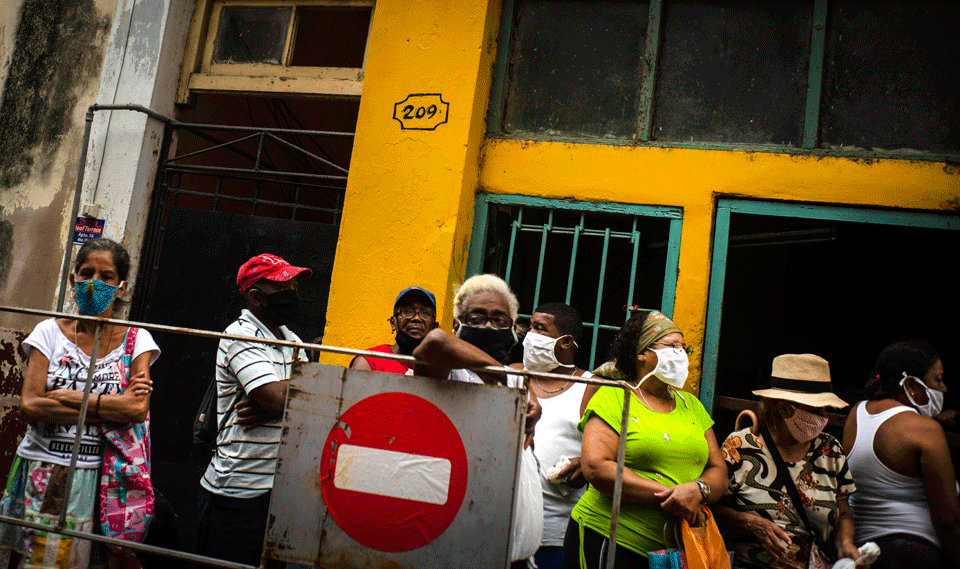
Food availability was the top concern of 21% of Cubans responding to a recent opinion survey, reflecting the recurrent food shortages on the island promoted by the U.S. economic blockade and the shortcomings of the domestic food supply system. In 1960, the idea of a blockade was appealing to the U.S. State Department because it would cause deprivation and suffering. Those intentions resurfaced in 1992 with the so-called Cuban Democracy Act, which, still in force, restricts foreign partners of U.S. companies from exporting goods to Cuba. It covers exports of food and agricultural supplies.
Cuba’s food supply system is presently unstable, due in part to a fragile Cuban economy. How it functions in the future will depend on the government’s management of agriculture and on the impact of the U.S. economic blockade. Economic fallout from the COVID-19 pandemic will also surely play a role.
Some of Cuba’s food problems won’t be fixed soon. The sugarcane monoculture that dominated for so long took a toll on soil fertility. The woody marabou plant, useful only for making charcoal and removable only with heavy machinery, has invaded 4.2 million acres of Cuban land—18 % of the total. Cuba has also recently experienced severe drought conditions interspersed with intense rains and flooding; 60% of the land is at risk of desertification. And the agricultural sector accounts for 40% of recent hurricane-related financial losses.
According to one report, the disempowerment of women in rural areas is another factor “impeding progress in the agricultural sector.” Furthermore, many young people lack the incentive to work in agriculture at the same time that the burden of feeding urban dwellers has increased. They accounted for 58% of the population in 1960 but hit 77% by 2018.
Cuba’s food supply problem manifests in the perennial need to import 60-80% of what Cubans eat, at an annual cost of $2 billion.
Beginning in 2008, the Cuban government instituted economic changes affecting the entire society, agriculture included. The government and Communist Party alike fashioned ambitious documents that outlined comprehensive reforms. The first was the Party’s 2011 “Guidelines for Economic and Social Policies.”
In 2008, private individuals and collectives gained long-term usage rights to small tracts of land. Now some 500,000 new, independent farmers work 4.9 million acres of agricultural land. Private farmers in general, new and old, occupy 5.93 million acres, which yield almost 80% of Cuba’s domestically-produced food.
The largest class of farmers, the UBPC cooperatives, heirs of the dismembered state farms, control 8.42 million acres of Cuba’s total of 15.56 million acres of arable land; another 1.16 million acres still remain idle and unfarmed.
The new private farmers ought to be producing “even more food,” says one observer. Supplies, equipment, spare parts, fertilizers, and seeds provided by state agencies are often unavailable, delayed, or of low quality, however. Access to credit and insurance appears limited.
Cuban farmers also face gasoline and diesel fuel shortages, mainly because of drastically reduced shipments from Venezuelan oil producers, paralyzed by U.S. sanctions. The impact of these restrictions on food production in May 2019 led to increased food rationing.
The food distribution system on the island is also inefficient, hampering efforts to get out what food is available. The National Union of [food] Collection, otherwise known as the “Acopio” (“collection” in English) is the Agriculture Ministry entity responsible for distributing food. Problems plaguing Acopio include delayed payments to producers, inadequate storage facilities, transportation delays, regional variations in service, and “cumbersome” criteria for defining food quality.
The Acopio operates some 400 state agricultural markets and 1,200 other food-selling facilities. When shopping at them, consumers experience long wait times, unavailability of desired food products, and variable quality. Vendors setting their own prices often reserve higher quality food for consumers paying with the convertible currency used by foreign visitors. Cubans relying on rationed food, by contrast, may be left with lower quality food and smaller amounts—while also being forced to pay high prices for food they still lack.
Some government efforts at bolstering food supplies look like the ecologically-oriented initiatives for feeding urban populations that appeared during Cuba’s so-called “Special Period” of the 1990s, when it lost all its main trading partners after the fall of the Soviet Bloc. They bear names like “Program for Municipal Self-supply,” “the Program of Urban, Suburban, and Family Agriculture” (focused on growing food in small spaces), and the “Program of Local Support for Agricultural Modernization,” for 37 municipalities.
Speaking in February, Cuban President Miguel Díaz-Canel called for local self-sufficiency and for the Acopio to collect farm products promptly and thoroughly. With more food arriving at markets, he suggested, the state could regain control over food sales and prices, and thereby push out speculators and black marketeers. Later, Díaz-Canel spoke approvingly of producers bypassing the Acopio and selling at local markets. There’s discussion of “participation of other state and non-state actors” in the Acopio system.

Citing the examples of Vietnam and China—socialist countries that export food—reformers propose using remittances from Cubans living abroad for investing in food production, thus promoting farmer autonomy. Díaz-Canel recently advocated greater involvement of scientists and academics in food production, just as has been done with the coronavirus pandemic.
Overall, the official response to food supply problems seems to lack focus and coherence. If so, maybe it’s because planners are stymied as they deal with a regimen of shortages cemented in place and intractable.
The imagination sees a specter-like U.S. presence as government officials deliberate and as farmers and consumers complain. It’s in the room as officials look abroad to transfer money, secure credit, import food, and seek investment in agriculture, or when they want to import farm machinery, tools, spare parts, premium seeds, fertilizers, pesticides, purebred livestock, and hydrocarbon fuels.
U.S. pressures on foreign financial institutions are unrelenting. Foreign suppliers face merciless penalties if they ship agricultural supplies to Cuba, especially if they have associations with U.S. companies or if their goods contain some tiny U.S. component.
When agricultural projects end up badly in Cuba or when food is short, surely recriminations crop up and perhaps animosities and anti-government ideas also. These would be exactly what the U.S. doctor ordered.










